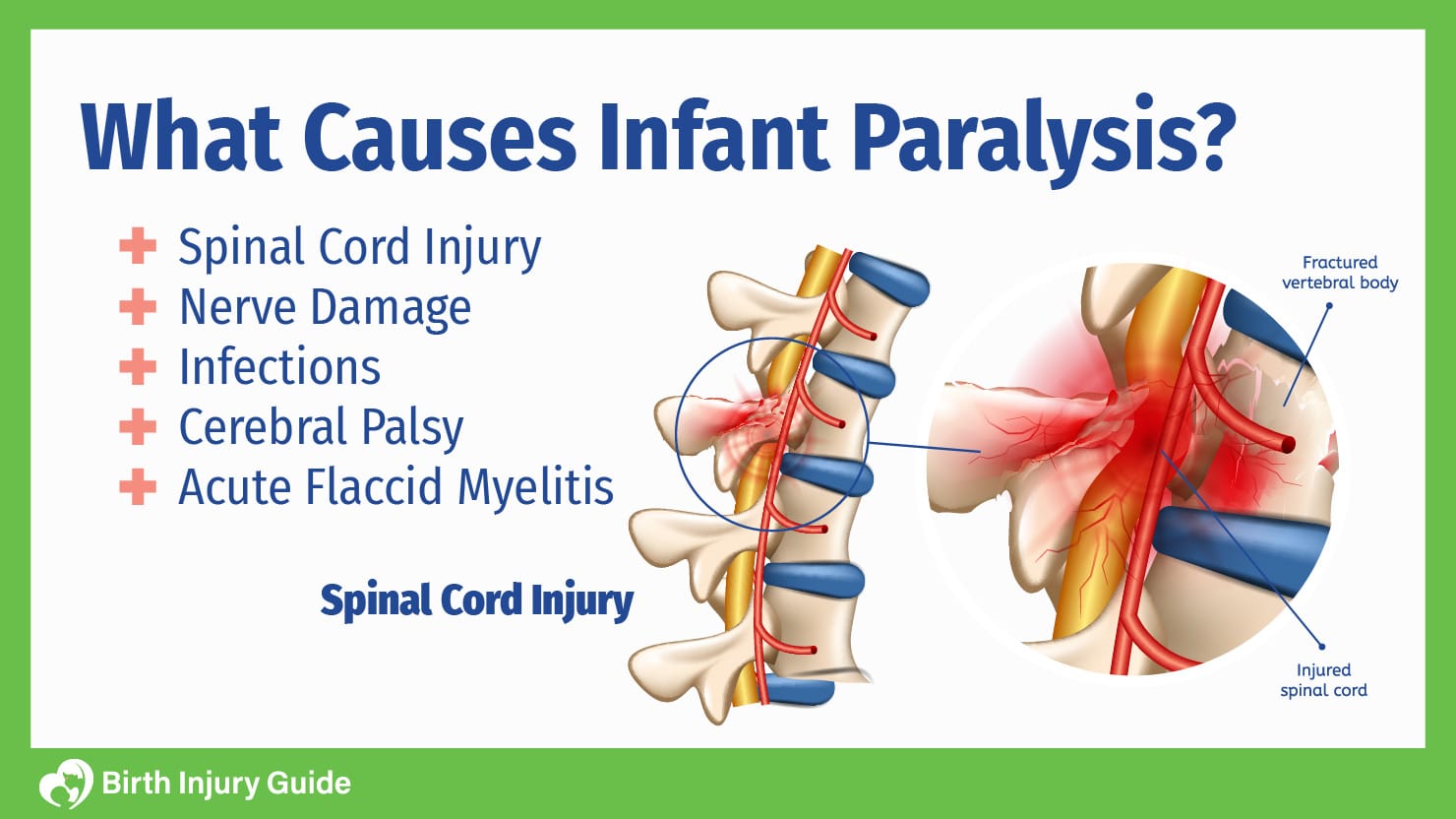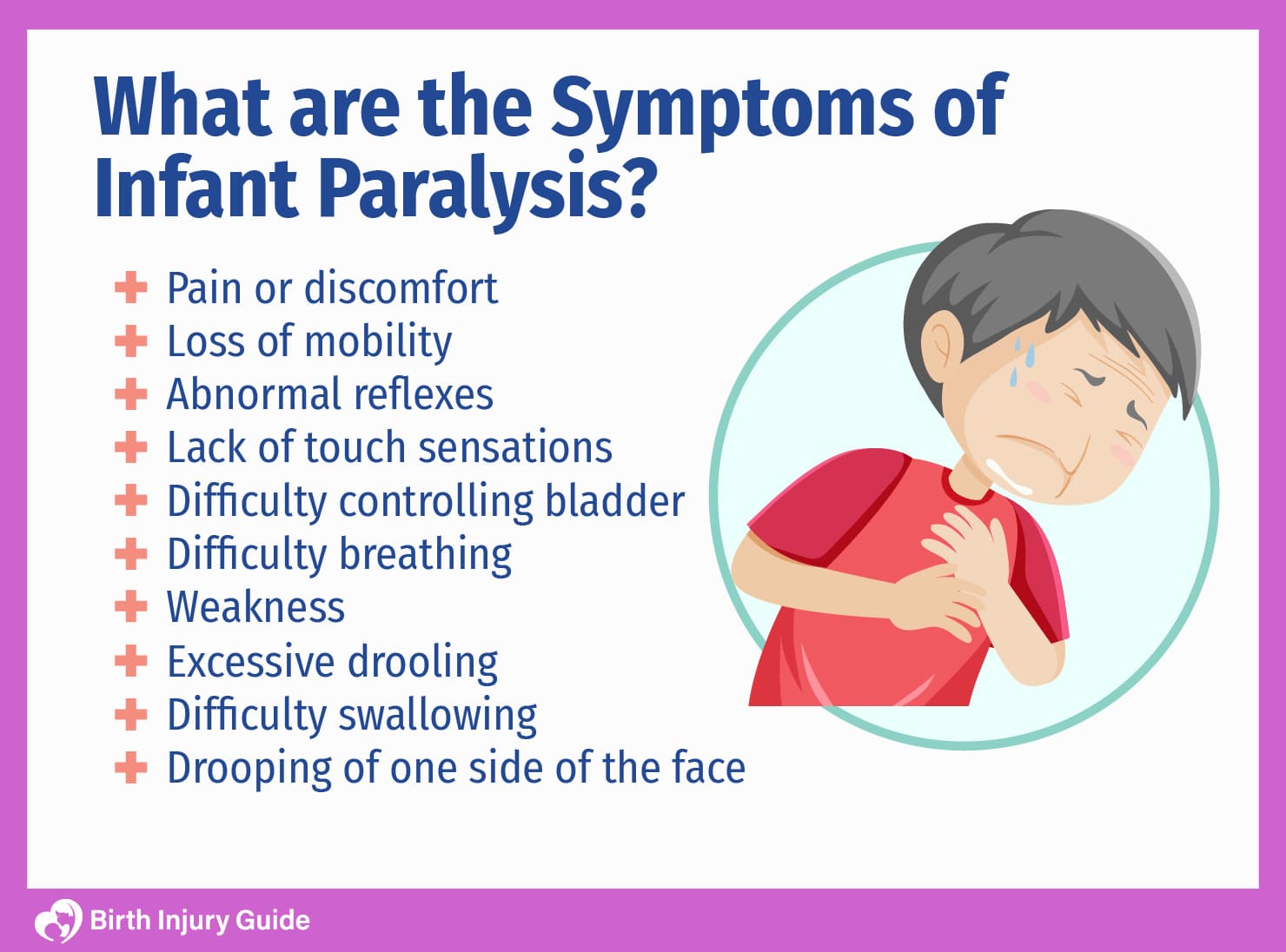
What Causes Infant Paralysis?
The recent spike in the mysterious illness called acute flaccid myelitis (AFM) has caused concern among parents all over the United States. Parents are now, more than ever, asking questions like “what causes infant paralysis?”, “what are the symptoms of paralysis?”, and “is infant paralysis treatable?” The answer to these questions may reside in the details of the case itself. There is very little known about AFM, though other disorders or injuries that cause paralysis may be more easily treated.
In this post, we will take a look at some of the most common causes of infant paralysis, and provide helpful information for parents. As always, parents who have questions about their legal rights can contact Birth Injury Guide directly to learn more.
What Causes Infant Paralysis?
The causes of infant paralysis vary, and many are unique to the infant and his or her overall health and medical history. Here are some of the most common causes of, and conditions related to, infant paralysis:

- Spinal Cord Injury: Spinal cord injuries commonly cause paralysis, and can impact various structures in the body. Spinal cord injuries may occur during birth if the doctor uses too much force, or incorrect rotational stress is applied to the infant. These injuries can also result from inappropriate use of assistive tools, including vacuums and forceps.
- Nerve Damage: Nerve damage is one of the most common causes of infant paralysis. Most often, the nerves that are damaged are those in the shoulder (shoulder dysplasia), neck, and arms. Examples of nerve injuries include:
- Brachial Plexus Injury: Damage to the brachial plexus nerve group can cause paralysis in the shoulder, arm, and hand of the affected side. This injury is common when the infant is positioned awkwardly in the birth canal, and forceful delivery is required.
- Erb’s Palsy: Erb’s palsy is the name of a disorder associated with nerve damage to the upper plexus nerve roots (C5-C6). Unlike brachial plexus injuries, Erb’s palsy occurs when the nerves along the entire arm are damaged.
- Klumpke’s Palsy: Klumpke’s palsy occurs when only the nerves in the lower plexus roots (C8-T1) are injured.
- Facial Paralysis: Facial paralysis most commonly occurs when forceps are used during delivery. When pressure is applied to the infant’s face, nerves can be damaged. Most cases of facial paralysis are temporary, but severe nerve damage can be permanent.
- Diaphragm Paralysis: The diaphragm is an important muscle that separates the organs in the chest from the abdomen. If the nerves in the diaphragm are damaged, the infant may have difficulty breathing.
- Infections: If a pregnant woman develops an infection, it can easily be transmitted to the infant. Infections like syphilis can harm an infant, and can lead to injuries including developmental impairments and paralysis.
- Cerebral Palsy: Cerebral palsy is a neurological disorder that affects muscle movements, balance, coordination, and mobility. Some infants with cerebral palsy experience spastic movements, while others may experience partial or complete paralysis of certain parts of their bodies. One of the most severe forms of cerebral palsy is quadriplegic cerebral palsy, which affects every limb, and causes complete loss of reflexes.
- Acute Flaccid Myelitis (AFM): AFM is a serious condition affecting the nervous system. Currently, doctors and the Centers for Disease Control and Prevention (CDC) are not sure exactly what causes AFM, but they do know the damage it can cause. AFM most commonly impacts infants and children under four years old. Children with AFM may experience sudden weakness, loss of muscle tone, loss of reflexes, or total paralysis.
What are the Symptoms of Infant Paralysis?
The symptoms associated with infant paralysis may vary depending on the cause and extent of the injuries. There are, however, some symptoms that are generally consistent among infants and children with paralysis, regardless of the cause.

These symptoms include:
- Pain or discomfort
- Loss of mobility
- Abnormal reflexes
- Lack of touch sensations
- Difficulty controlling bladder or bowels
- Difficulty breathing
- Weakness
- Excessive drooling
- Difficulty swallowing
- Drooping of one side of the face
While these symptoms are the most common and consistent among the disorders we have discussed, there are many variables that may impact the symptoms your child exhibits. Contact your child’s doctor if you are concerned about any of these symptoms.
Is Infant Paralysis Treatable?
It is important to remember that a “treatment” and a “cure” are two very different things. Many forms of infant paralysis cannot be “cured”, but the symptoms may be “treatable”. Parents should not lose hope if their doctor says that their child cannot be cured. Treatment options are often successful at increasing movement, mobility, control, and independence.
Some of the best treatment options for infant paralysis include:
- Therapy: Depending on your child’s overall health, your doctor may recommend physical, occupational, behavioral, and/or speech therapy to help your child. Physical therapy is one of the most important treatments, as it can help strengthen damaged nerves and muscles, and improve function in injured parts of the body.
- Medication: Depending on the cause and other health considerations, your child may be prescribed medication to help with movement, pain, or muscle control.
- Surgery: Severe nerve damage may require surgical intervention to repair the damage and restore function.
Discuss treatment options with your child’s healthcare team to find options that support his or her overall health. Many children with paralysis go on to live normal lives and enjoy the same activities as their peers who have never experienced paralysis.
What do We Know about AFM?
So far in 2018, the CDC has confirmed 72 cases of AFM across the U.S., and is investigating another 119 possible cases. The number of confirmed cases each year has increased since the first case was discovered in 2014. Since that time, the CDC and other medical experts have been working to determine the cause and hopefully find a cure. While enteroviruses, West Nile, and other viruses have shown up in samples from confirmed cases, none of the cases have been linked to a specific virus or bacteria, and there is little consistency in test results.
The CDC believes that AFM is caused by a virus, but the origin has not been established. In most cases, infants and children who have developed AFM begin exhibiting signs of a common cold, flu, or ear infection. Within a few days – and often suddenly – paralysis sets in, even though the initial symptoms may have improved or be gone.
If your child has exhibited symptoms of a virus and you notice additional symptoms like weakness, drooping, slurred speech, or inability to move properly, contact your child’s doctor immediately. Your doctor will need to examine your child’s nervous system and spinal cord, and will most likely perform an MRI and labs (blood or urine).
Get Help with Your Infant Paralysis Case
If your infant or child has been diagnosed with paralysis, you should know that you are not alone. There are many support groups and organizations that can help you get the best care possible for your child. There are also people who can help your family stay financially secure as you move through this difficult time.
If you have legal questions, or are concerned that your child was injured as the result of negligence, you also have legal support here at Birth Injury Guide. We care about your family and are here to help. Fill out our online form for a free case review, and get the help you need.

